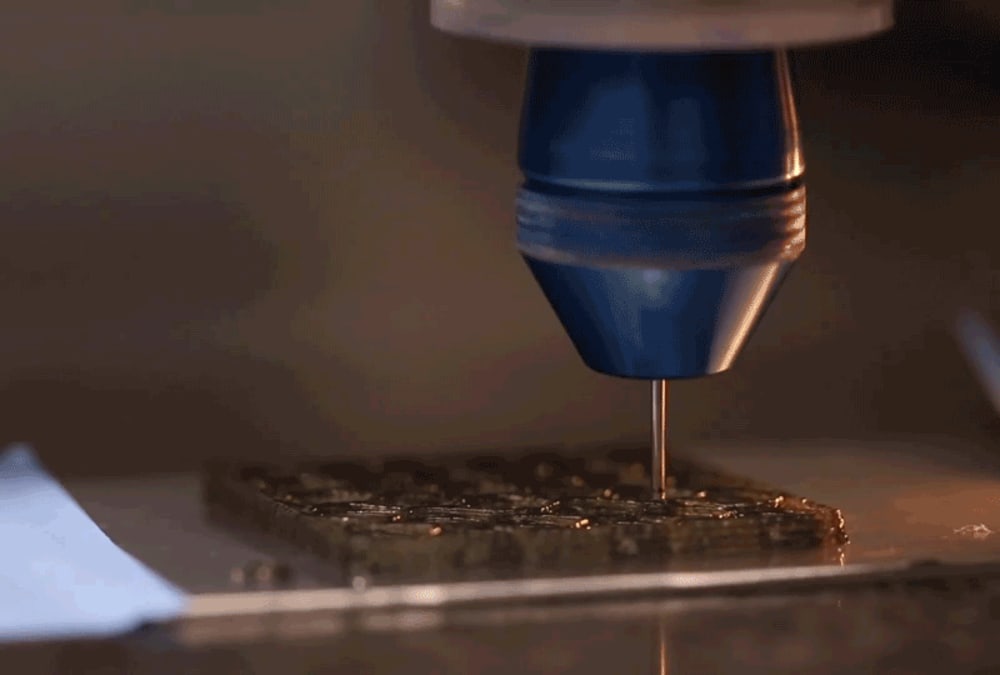Composite materials, found naturally in teeth and shells, or synthetically as reinforced concrete, car tires and plywood, rely on the arrangement of fibers to create superior strength. In man-made objects however, the challenge is still replicating nature’s way of doing things.
With rotational 3D printing, a team from the award winning Lewis Lab at Harvard John A. Paulson School of Engineering and Applied Sciences (SEAS) have developed a way of controlling fiber orientation within a material, putting FFF 3D printers in a spin.
The study’s senior author, Jennifer A. Lewis, comments, “We can now pattern materials in a hierarchical manner, akin to the way that nature builds.”
Rotational 3D printing. Image courtesy of Brett Compton/SEAS.
Go with the flow
A number of other methods using magnetic or electric fields have been used before as a means of arranging fibers in a polymer mixture. Adding these currents however adds another level of complexity to an otherwise fairly simple deposition process.
Instead, the Lewis Lab’s method works with the rheology – or how things flow – of a 3D printer ink, essentially a liquid current, to align fibers in the mix.

In a spin
In place of a standard extruder, the lab’s 3D printer has a rapidly rotating nozzle, which is used to deposit a liquid, epoxy-based, feedstock rather than a wire filament. By precisely choreographing the speed and rotation of the nozzle the team are able to effectively program fiber arrangement and content to give varying material stiffness throughout a part.
“One of the exciting things about this work,” explains co-author Jordan Raney, “is that it offers a new avenue to produce complex microstructures, and to controllably vary the microstructure from region to region.”
“More control over structure means more control over the resulting properties, which vastly expands the design space that can be exploited to optimize properties further.”
Then-postdoctoral fellow at Harvard University, Raney is now Assistant Professor of Mechanical Engineering and Applied Mechanics at the University of Pennsylvania where he works on, amongst other things, “new methods to control the internal structural features of materials systems.”
Nano to macro
Independent of electrical or magnetic currents, rotational 3D printing is a versatile method that can be used in any material extrusion method (FFF/FDM, direct ink-writing, BAAM) and to deposit any filler material, including carbon fibers and ceramic platelets.
Another co-author, Brett Compton, is now Assistant Professor in Mechanical Engineering at the University of Tennessee, Knoxville, and has worked on research for Oak Ridge’s Big Area Additive Manufacturing (BAAM) method.
Results of the study, co-authored by Brett Compton, Jordan Raney, Jochen Mueller and Jennifer A. Lewis, are due to be published in the PNAS journal . The project was completed with the support the Office of Naval Research and GETTYLAB, a financier of tool-builders based in Germany, and intellectual property is protected by the Harvard Office of Technology Development.
Nominate the leading research teams in the 2018 3D Printing Industry Awards here.
Subscribe to the 3D Printing Industry newsletter, follow us on Twitter, and like us on Facebook here.
Featured image shows rotational 3D printing nozzle at Harvard. Photo by Brett Compton/SEAS




